I originally wrote this piece earlier in the summer when Neymar’s move from Barcelona to Paris-Saint Germain was a swirling rumour, but as I couldn’t find anyone interested in publishing it, I’m breaking my golden rule and writing a football-related post on here. I found myself wondering how often breaking the world transfer record works out, and how often it doesn’t. Since this was written, Neymar has made his move to the French capital in the first deal to exceed £100m (and, indeed, the first to hit £200m), while Barcelona have also smashed the £100m barrier to bring in Borussia Dortmund’s exciting young forward Ousmane Dembélé.
It came to my attention prior to publishing this that Sky Sports had had the same idea. But someone was always going to, so I make no apologies for publishing this anyway!
Brazilian superstar Neymar is seemingly on the verge of a £200m move from Barcelona to Paris-Saint Germain, though it remains to be seen whether the eye-wateringly expensive deal ultimately goes through. But just how successful have world record signings been in the modern era? Beginning with the advent of the UEFA Champions League in 1992, I ask whether buying clubs received enough bang for their world record buck.
1) 1992 – Jean-Pierre Papin – Marseille to AC Milan – £10m
No year has seen the world transfer fee record broken more times than 1992. The first of the trio of unprecedented big-money moves saw AC Milan become the first club to break the £10m barrier by bringing in French forward Papin from Marseille. Papin had a remarkable record in France, scoring plenty of goals and winning an array of domestic trophies, as well as the Ballon d’Or.
However, things didn’t go quite so well in Italy – arguably Europe’s strongest league at the time. Papin did manage a decent scoring rate for the Rossoneri, but injury problems hampered his attempts to settle into life at the San Siro, and he left for Bayern Munich after just two seasons. Despite his struggles in Italy, Papin still achieved a strike ratio just shy of one goal every two matches, not bad considering the player’s fitness battles.
VERDICT – A quality player worth every penny on paper, injuries prevented Papin from truly living up to the world record price tag at Milan.
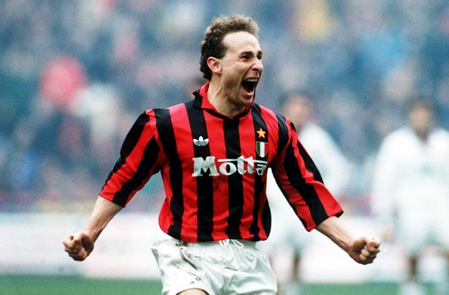
Jean-Pierre Papin
2) 1992 – Gianluca Vialli – Sampdoria to Juventus – £12m
In a sign of the strength of Italian football during this period, it wasn’t long before Juventus eclipsed Milan’s outlay on Papin by splashing out £12m to bring in Sampdoria striker Gianluca Vialli. Vialli’s prolific partnership with Roberto Mancini had helped deliver Sampdoria their most successful period, so it was no surprise when a giant of Italian football stepped in to claim the club’s prized asset.
Vialli’s first two seasons with Juve saw him struggle to find the kind of form that made him such a hot property at Sampdoria, while injury problems meant he was restricted to just 10 appearance in his second season. However, after working hard to improve his strength and fitness, Vialli’s third and fourth seasons with the club were much more prolific, helping endear him to Juve supporters. His goals would help Juventus to a league and cup double in 1995, followed by Champions League glory a year later.
VERDICT – After a difficult start, Vialli ultimately proved to be money well spent as he helped fire the Old Lady to glory.
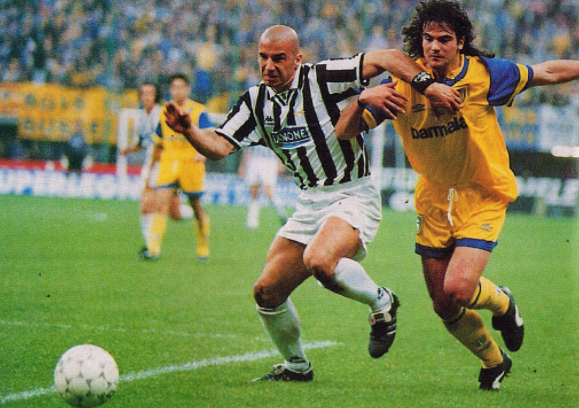
Gianluca Vialli (left) takes on Parma’s Fernando Couto
3) 1992 – Gianluigi Lentini – Torino to AC Milan – £13m
It wasn’t long before Milan reclaimed their title as the game’s biggest spenders from rivals Juventus, but the story of Gianluigi Lentini is laced with sadness. The winger had built up a stellar reputation for pace and trickery during his time with boyhood club Torino, helping them achieve promotion to Serie A and then challenge towards the top of the table.
A year after signing for Milan for a world record fee, Lentini was involved in a serious road traffic accident that left him with a litany of injuries, including a fractured skull. Remarkably, he recovered sufficiently to return to action, but health issues in the wake of the accident continued to hinder his game and prevented him from performing at his previous best. Despite this, he still claimed an impressive list of honours during his four seasons with the Rossoneri, including the Champions League, three Serie A titles, and the Italian Super Cup.
VERDICT – To come back from the injuries sustained in his car accident and play for Europe’s best team at the time attests to Lentini’s strength of character. Although he may not have hit the heights he was surely destined for, his list of achievements despite such challenging circumstances makes it churlish to declare Lentini anything but a success.
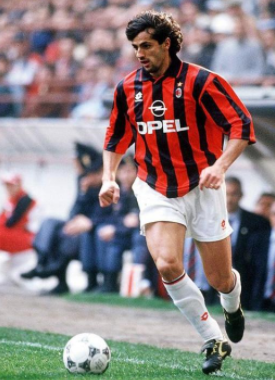
Gianluigi Lentini
4) 1996 – Ronaldo – PSV Eindhoven to Barcelona – £13.2m
Ronaldo Luís Nazário de Lima is one of only two players to break the world transfer record twice (the other is Diego Maradona), during a career which saw him become, for many, the greatest ever out-and-out goalscorer. The Brazilian arrived in Europe as a teenager at relatively unfashionable PSV Eindhoven, and his record of a goal a game during his two seasons in the Netherlands caught the eye of Europe’s biggest clubs. There seemed little doubt that, as the world record fee was broken for the first time in four years, Ronaldo would be a hit at Barcelona.
Sadly for the Catalan outfit, they couldn’t keep hold of their prolific new signing for more than one season. Ronaldo was indeed a phenomenal hit at Camp Nou, scoring a procession of often breathtaking goals, winning World Footballer of the Year, the Copa del Rey and the UEFA Cup Winners’ Cup. While observers struggled for superlatives to describe the young Brazilian’s exploits, behind the scenes, there were problems. Attempts to renegotiate his contract broke down, and Barcelona were forced to part with the man they called O Fenômeno, as he departed for Inter Milan, admittedly with the consolation of another world record fee.
VERDICT – Barcelona got one season of sheer brilliance out of Ronaldo. However, their failure to tie the player down to a stay of longer than just a solitary season means his time at the club is tinged with a hint of regret.
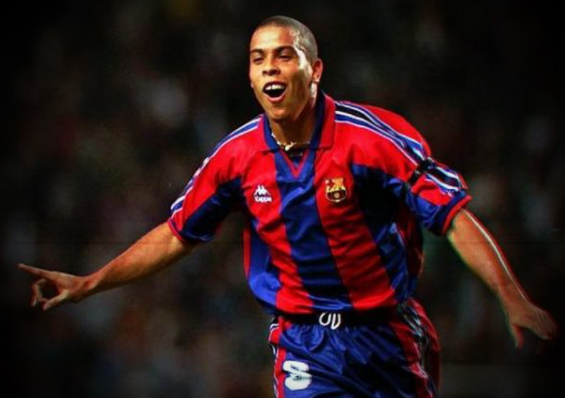
Ronaldo
5) 1996 – Alan Shearer – Blackburn Rovers to Newcastle United – £15m
When powerful striker Alan Shearer left Premier League champions Blackburn Rovers to join boyhood club Newcastle United, an English club broke the world transfer fee record for the first time since 1951. Shearer’s goals, allied to his formidable strike partnership with Chris Sutton, had fired Blackburn to the title in 1995, but as the club struggled to recapture that form in the following season, it seemed increasingly inevitable that Shearer would leave. Perhaps his strongest suitor was Alex Ferguson at Manchester United, but with Blackburn reluctant to sell to their closest rivals at the top of the Premier League and Shearer himself set on a move home, it was Newcastle who found themselves in pole position.
Shearer was made for the Magpies. A local hero the passionate Toon Army could worship, and willing to disregard the overtures of Manchester United, Shearer went on to become the Premier League’s all-time highest goalscorer, revelling in the adulation of the supporters to whom he could so readily relate. Sadly, the Premier League title at Blackburn was Shearer’s last ever trophy – he won no silverware during his time with Newcastle. But you can bet he has no regrets.
VERDICT – They may not have won any trophies, but Shearer’s goals were a source of endless joy on Tyneside and provided a generation of Newcastle fans with some of their most treasured memories. A snip at £15m.
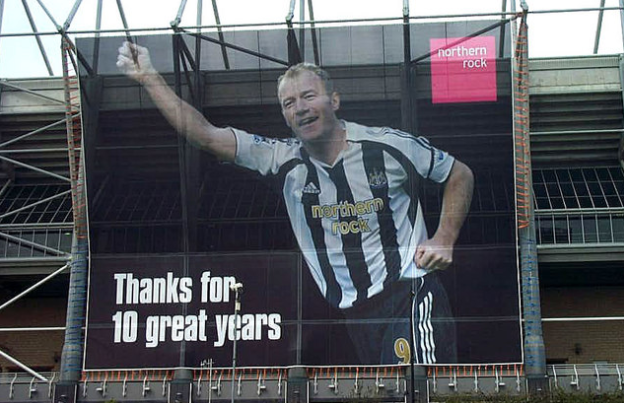
Alan Shearer gracing a banner at Newcastle’s St. James’ Park
6) 1997 – Ronaldo – Barcelona to Internazionale – £19.5m
As we’ve already seen, Ronaldo’s one season with Barcelona was an unbridled success. However, with his contract wrangle unresolved, Inter Milan were only too happy to stump up a world record fee to bring in the best striker in the business. The Brazilian’s time with Inter began exactly has his Barça spell had ended, with goals galore and personal accolades that attested to his sheer brilliance.
Sadly, it was at Inter where Ronaldo’s injury problems began, robbing him of some of his explosive power and keeping him sidelined for the entire 2000/2001 season. Ronaldo only won one trophy during his time with the club – the 1998 UEFA Cup – and he never recovered the form that pre-dated his knee issues. It wasn’t until his move to Real Madrid in 2002 that he recaptured some of his old magic.
VERDICT – Ronaldo’s early form in Italy suggests he would have been a huge hit, were it not for his serious knee injuries that ultimately took some of the shine off his time at Inter.

Ronaldo (left) celebrates a goal with Diego Simeone
7) 1998 – Denílson – São Paulo to Real Betis – £21.5m
One of the more leftfield world record breaking transfers saw Real Betis become the first club to break the £20m barrier when they splashed out on up-and-coming Brazilian winger Denílson, in the hope his mercurial talents could help them penetrate the upper echelons of La Liga. Just a teenager when he made his debut for the Brazilian national team, Denílson’s displays of skill and trickery saw him labelled as one of the games great prospects, but it was still a major surprise when the club that swooped to bring him to Europe was Real Betis.
Unfortunately for both club and player, Denílson did not live up to expectations. Despite establishing himself as a regular in the Betis line-up, his difficulties in adapting to life in La Liga saw him loaned to Flamengo in his homeland in 2000. He did return, but failed to nail down a regular starting place, eventually departing for Bordeaux in 2005. Denílson’s career tailed off after that, and the former world record signing now includes Hải Phòng of Vietnam and Greek side Nea Kavala among his former clubs.
VERDICT – It would have been fascinating to see Denílson live up to his potential in the green and white of Real Betis, but it wasn’t to be.
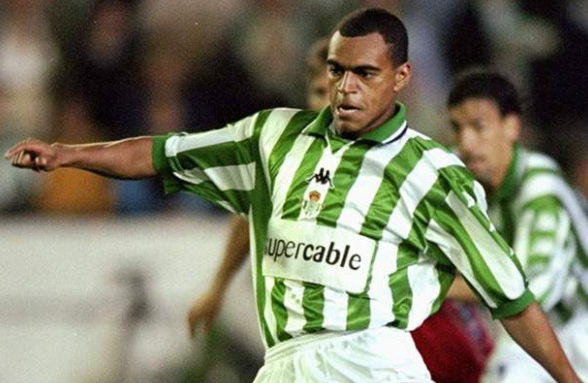
Denílson
8) 1999 – Christian Vieri – Lazio to Internazionale – £32.1m
Just a year after Real Betis became the first club to break the £20m mark in their signing of Denílson, the world record jumped above £30m as Inter snapped up prolific striker Vieri from Lazio. Unfortunately for Vieri, he joined a club struggling to challenge for titles in Italy, and the managerial merry-go-round at the San Siro often seemed to affect his form. The player was further hampered by injuries – especially during his earlier seasons with the club – that prevented him from forming a consistent partnership with Ronaldo.
Nevertheless, Vieri did flourish under the tutelage of Argentinian manager Héctor Cúper, scoring 25 goals in all competitions in 2001/2002 as Inter narrowly missed out on the title. Following Cúper’s departure, Vieri again began to struggle and his star ultimately waned, before a move to city rivals AC Milan that yielded just eight appearances.
VERDICT – A qualified success, but Inter could have hoped for more from a player for whom they smashed the world transfer record.
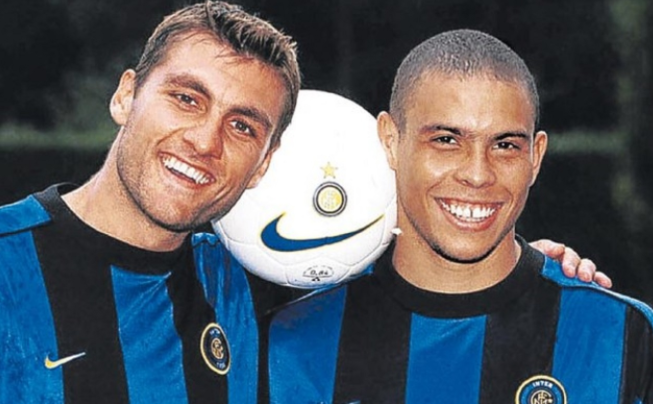
Christian Vieri (left) with Inter strike partner Ronaldo (and a football)
9) 2000 – Hernán Crespo – Parma to Lazio – £35.5m
After winning Serie A in 1999/2000 under Sven-Göran Eriksson, Lazio sought to bolster their efforts to defend their crown by splashing the cash on Parma’s gifted Argentinian forward Crespo. Despite failing in their efforts to retain the title, Crespo’s first season in Rome was a success as he scored 26 league goals, appearing to justify the huge price tag.
However, injuries curtailed Crespo’s influence in his second and final season at the club as several of Lazio’s big-name signings failed to make an impact. As the club began to feel the financial pinch, it became increasingly clear that they would need to sell. On the final day of August 2002, Crespo departed for Inter.
VERDICT – Having spent so much, Lazio would have hoped to have kept hold of Crespo for longer. However, the club’s financial problems forced their hand and meant the player never really had the time to make the kind of impact expected of the world’s most expensive player.

Hernán Crespo
10) 2000 – Luís Figo – Barcelona to Real Madrid – £37m
Portugal’s graceful, supremely gifted midfield maestro was the centre of one of the most controversial transfers of all time when Real Madrid, setting out on their Galáctico adventure, prised the player from bitter rivals Barcelona for a world record fee. The move turned Figo from a Camp Nou idol into a hate figure, and the atmosphere during visits to his old stomping ground with Real could be described as seething. Invective would rain down from the cavernous stands, accompanied by all manner of missiles, from liquor bottles to mobile phones.
Figo had been a star in Catalonia, helping Barcelona win two La Liga titles during his five seasons, as well as the Copa del Rey and UEFA Cup Winners’ Cup. He had already secured his place among the pantheon of the game’s greatest players, owing to his silky passing and elegant movement. Despite the controversy and furore surrounding his move to the Spanish capital, Figo settled in instantly at Real, taking his game to new levels, winning two La Liga titles, as well as the Champions League in 2002.
VERDICT – After one of the most acrimonious transfers in football history, Figo slotted into Real Madrid’s midfield with aplomb, helping to deliver trophies and establish the Galáctico phenomenon. A complete success.
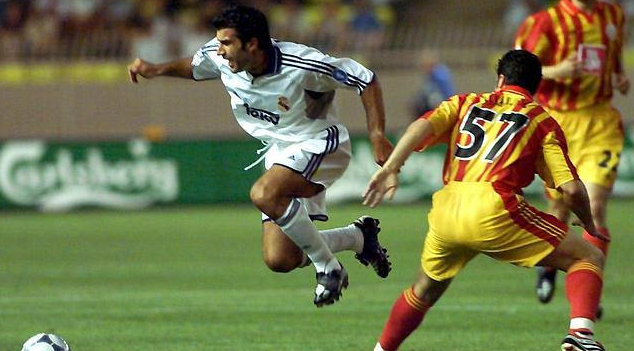
Luís Figo takes to the air in a clash with Galatasaray
11) 2001 – Zinedine Zidane – Juventus to Real Madrid – £46.6m
With the Galáctico era in full swing, Real Madrid signalled their status as the most powerful club in world football by smashing the world transfer fee record to sign Zidane from Juventus. The French international midfielder would go on to cement his place as one of the greatest footballers of all time, peppering his career with moments of sublime genius that often defied belief, possessing an ability to make the game look easy. Zidane’s first season at the Bernabéu ended in glory as he scored a spectacular volley in the Champions League final – one of that competition’s best ever goals – to secure victory.
Zidane, together with Luís Figo, ran the engine room at the heart of the Real midfield as the club won La Liga in 2003, and he also won FIFA World Player of the Year for the third time. Zidane went on to retire from football in 2006, having scored 49 goals in 225 games for the club. In January 2016, Zidane replaced Rafael Benítez as Real Madrid manager, and has already guided them to two Champions Leagues and one La Liga title.
VERDICT – A resounding success as a player, Zidane has only bolstered his standing among Real Madrid fans since becoming manager. There will never be another player quite like Zinedine Zidane.
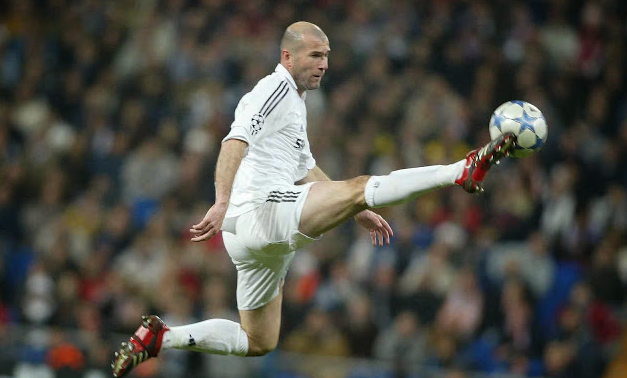
Zinedine Zidane
12) 2009 – Cristiano Ronaldo – Manchester United to Real Madrid – £80m
Real Madrid’s record fee paid for Zinedine Zidane stood for eight years before they decided to almost double it in signing Portuguese superstar Cristiano Ronaldo from Manchester United. In the wake of the prospective Neymar deal, it’s easy to forget how staggering the £80m it took to capture Ronaldo from a very reluctant Sir Alex Ferguson’s grasp seemed in 2009. But it’s fair to say that it has been money well spent. A flashy winger in his early days, Ronaldo developed at Old Trafford from a player who at times flattered to deceive into an attacking tour-de-force – a winger whose trickery, pace and awesome physical strength made him a formidable opponent. He also began to demonstrate an eye for goal well beyond that expected of most natural wingers.
After clinging on for as long as they could, United eventually relented and allowed the player to switch to the Spanish capital, and he hasn’t looked back since. Ronaldo’s physique and presence in the penalty area has seen him develop from a winger into a more orthodox centre-forward, and, at the time of writing, the player has scored a scarcely believable 406 goals in 396 appearance for Real Madrid. Ronaldo’s goals have helped the club to win two La Liga titles, three Champions Leagues and two Copa del Reys. In his ongoing rivalry with Barcelona’s Lionel Messi for recognition as the world’s best player (or even the best player of all time) Ronaldo has also won three Ballon d’Ors during his time at Madrid and, at the age of 32, continues to perform at the very highest level.
VERDICT – Real knew they were investing in a supreme talent when they lavished £80m to sign Ronaldo, but even they probably didn’t realise just what he would go on to achieve.

Cristiano Ronaldo
13) 2013 – Gareth Bale – Tottenham Hotspur to Real Madrid – £86m
For the fourth time in a row, Real Madrid demonstrated their awesome spending power by breaking the world transfer record, this time to secure pacy Welsh winger Gareth Bale from Tottenham. Bale had emerged as a talented but raw young left-back at Southampton, before a move to Spurs that initially saw him struggle to make an impact. A move to a more advanced, wide attacking role saw Bale develop into a player whose frightening speed made him one of the most feared players in the Premier League. A Champions League hat-trick in the San Siro against Inter Milan in 2010/2011 announced the player onto the world stage.
By the time of his move to Spain, Bale had added real physical power to his game. The pace that was his trademark remained, but he had also discovered an eye for goal. However, despite this progress, Bale has never fully endeared himself at the Santiago Bernabéu. Often treated as a scapegoat and sometimes frustrated by injury, Bale’s Real career has sputtered, rather than roared, into life. Almost since the day he signed, he has been linked in the press with a move to Manchester United, though this has always been vehemently denied by the player himself. Despite these issues, Bale has scored some important goals for his club, including a Champions League final winner against city rivals Atlético, and his tally stands at a creditable 67 goals in 150 appearances at the time of writing.
VERDICT – Some of the criticism aimed at Bale from sections of the Real support has been harsh. It is debatable whether Bale has lived up to the tag of world’s most expensive player, but he has proven to be a qualified success in Spain.

Gareth Bale
14) 2016 – Paul Pogba – Juventus to Manchester United – £89m
The most recent world record fee was not without its share of controversy and intrigue, and involved Manchester United paying £89m for a player they’d allowed to leave for free just four years earlier. French midfielder Pogba’s departure from United in 2012 was acrimonious, with Sir Alex Ferguson critical of the emerging talent’s decision not to sign a new contract at Old Trafford. After signing for Juventus, Pogba developed into the engine at the heart of Italy’s dominant force, winning the Serie A title in each of his four seasons at the club. As his power and drive began to increase, Pogba also secured a regular berth in the French national side.
Meanwhile, Manchester United appeared to be crying out for a midfield general to help boost their waning fortunes, and there was some regret about letting Pogba leave so easily. When José Mourinho came to the helm in summer 2016, bringing the player back to Old Trafford became a priority, even if that meant breaking the world transfer record. Indeed, some reports suggested a bid in excess of £100m may be necessary to convince Juventus to part with a player they desperately wanted to keep. Pogba’s first season back in a red shirt saw United finish a disappointing sixth in the Premier League, but two trophies were secured in the shape of the Europa League and EFL Cup. Pogba came in for criticism, with many suggesting that his performances did not befit the world’s most expensive player. At 24, however, Pogba has plenty of time to raise his game.
VERDICT – Far too soon to say whether £89m is money well spent, but United will be looking for far more from Pogba than they saw in his first season back at the club, and will hope the recent signing of Nemanja Matić can free the player from his shackles.

Paul Pogba celebrates a goal with his teammates
A warning to PSG then: breaking the world transfer record doesn’t always guarantee success. As many of the above demonstrate, injuries can seriously disrupt even the most promising of careers, and some players just don’t shine as expected. Nevertheless, when a player lives up to the price tag, it usually equals trophies. If Neymar does make the switch to Paris, he will almost certainly dominate the French domestic scene. The success of the deal will be measured by what the club achieves in Europe. Bonne chance!























